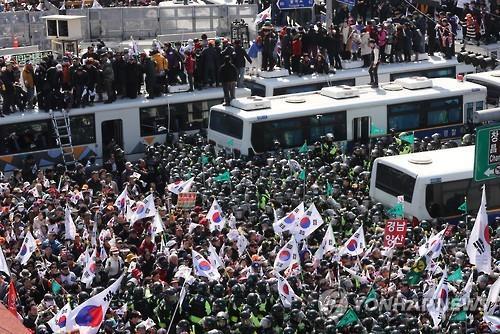[Herald Interview] ‘Police should enable, not limit protests’
By Ock Hyun-juPublished : April 19, 2017 - 14:41
In recent months, the world witnessed South Koreans take to the streets weekend after weekend intent on ousting President Park Geun-hye from power.
The demonstrations were hailed as a sign of a maturing democracy, but the country’s rallies have not always been peaceful. They have at times been marred by clashes between police and protesters, triggering debate over who is to blame for the eruptions of violence.
The demonstrations were hailed as a sign of a maturing democracy, but the country’s rallies have not always been peaceful. They have at times been marred by clashes between police and protesters, triggering debate over who is to blame for the eruptions of violence.

On March 30, three protesters died -- two from heart attacks and one after being hit by a loudspeaker that fell from a police bus -- while protesting against the Constitutional Court’s ruling to uphold the parliamentary impeachment of Park.
The rally turned violent as protesters angrily reacted to the decision, brandishing wooden sticks, pushing police officers and clambering over the police buses that cordoned off access to the court building.
Anja Bienert, a senior officer for Police and Human Rights Program at Amnesty International, pointed out that the recent case underscores the importance of the role of police as guards of peaceful protests.
“Anyone could have guessed there could be a lot of disappointment, frustration and anger, depending on the court’s decision,” she said in an interview with The Korea Herald. “In such an emotional situation, protesters would like to express their feelings in a way they are heard and seen by those who made the decision.”
Bienert, who oversees policing tactics of governments around the world and sets out recommendations, visited Korea last month to give a presentation on the state’s role in facilitating peaceful assembly at a forum co-hosted by the Amnesty International’s Korea Office, National Human Rights Commission of Korea and lawmakers.
“Police bus barricades, which have become a symbol of repression, and large numbers of police only contribute to increasing anger and tension there,” she said, adding that the physical appearance of police and their gear can be “threatening” and “intimidating.”
Debate over the use of police force and the freedom of assembly ensued in 2015 when farmer Baek Nam-gi was knocked unconscious by a water cannon blast during an anti-government protest. He died last year, after 317 days comatose in a hospital.
He was part of a rally in which protesters were trying to bring down police bus barricades with ropes to march toward their target audience -- Park. The police were using water cannons loaded with diluted tear gas to stop the crowd from reaching the presidential office.
Protesters accused the police of using excessive force and restricting the freedom of public assembly, while police said they needed to use bus barricades and water cannons to maintain public order.
But Bienert said the freedom of peaceful assembly and the police’s duty to keep public order do not have to be in conflict if police would stop anticipating violence from the outset.
“By showing the facilitative attitude, police have the best option to make the assemblies remain peaceful and orderly.”
The police’s response to protesters for the past few months has shown some improvement, she said, given that police have not used water cannons and protesters have been allowed to hold demonstrations on the capital’s main roads.

But there is still long way to go, Bienert said.
"The police have skills and competence to adopt a human rights compliant approach, but they lack the legal framework,” she said.
The country’s Constitution stipulates the freedom of peaceful assembly without licensing or censorship. But the Assembly and Demonstration Act requires rally organizers to apply for a permit 48 hours prior to an assembly.
Police can issue bans on assemblies when they are thought to pose serious threats to public security, disrupt traffic or disturb residents’ private lives. Staging an outdoor demonstration within a 100-meter radius of key governmental buildings such as the presidential office, the National Assembly and the Constitutional Court can also be forbidden.
“Legislation should make it clear that the freedom of public assemblies comes first and the police’s main task is to facilitate the fundamental human right,” she said. “Bans on rallies at specific times and certain places should also be lifted.”
According to an analysis by civic group People’s Solidarity for Participatory Democracy, the police banned 1,059 rallies in Seoul from 2011 to August 2016, with the most cited reason being obstruction of traffic, at 42.2 percent.
In early November, the police prohibited a massive candlelight vigil to demand Park’s ouster, which had been scheduled for Nov. 4 in the main boulevard in central Seoul, citing traffic disruption.
But a local court overturned the police’s decision. It said in the ruling, “It is difficult to see that the public good the smooth flow of traffic can bring outweighs the freedom of public assembly.”
“Police need to balance conflicting interests,” she said. “But the use of public space for the purpose of assemblies is at least as legitimate as traffic flow, tranquility in the neighborhood and commercial activities.”
“To some degree, some noise and disturbance are inherent to the rights to peaceful assemblies and need to be accepted.”
After all, it is impossible to prevent every individual from engaging in violence. But police and protesters willing to steer demonstrations in a peaceful way can influence others, she noted.
“The way they behave, the attitude they display exert influence and can even lead to violence,” she said. “The police need to be aware that they are not simply reacting. They are acting.”
By Ock Hyun-ju (laeticia.ock@heraldcorp.com)
-
Articles by Ock Hyun-ju








![[Kim Seong-kon] Democracy and the future of South Korea](http://res.heraldm.com/phpwas/restmb_idxmake.php?idx=644&simg=/content/image/2024/04/16/20240416050802_0.jpg&u=)








![[KH Explains] Hyundai's full hybrid edge to pay off amid slow transition to pure EVs](http://res.heraldm.com/phpwas/restmb_idxmake.php?idx=652&simg=/content/image/2024/04/18/20240418050645_0.jpg&u=20240418181020)

![[Today’s K-pop] Zico drops snippet of collaboration with Jennie](http://res.heraldm.com/phpwas/restmb_idxmake.php?idx=642&simg=/content/image/2024/04/18/20240418050702_0.jpg&u=)